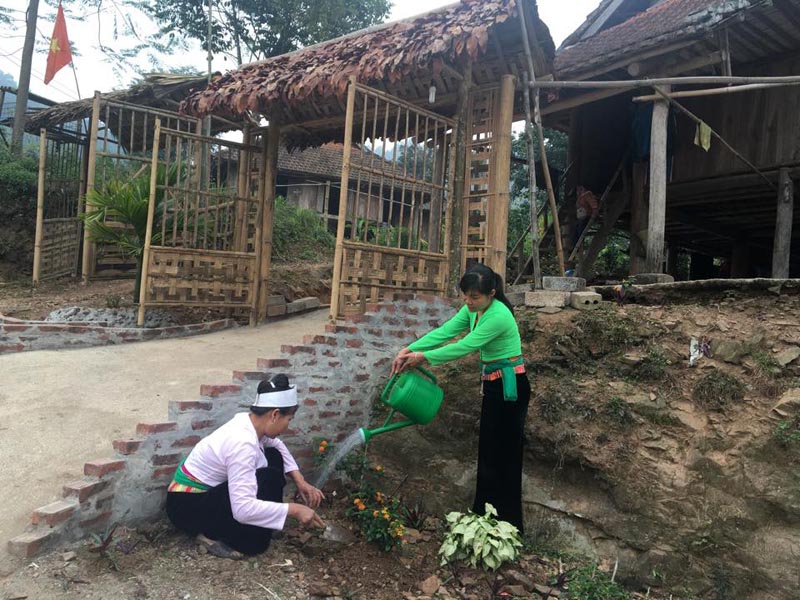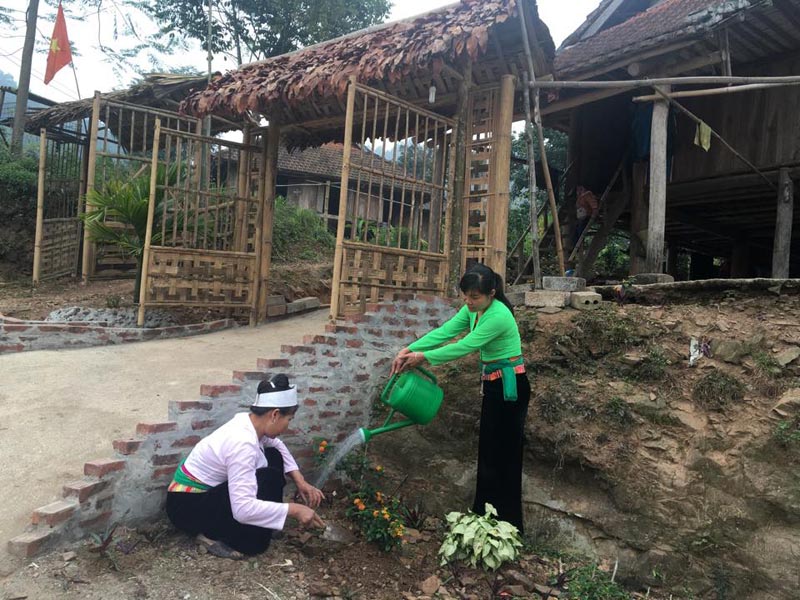
(HBO) - Ai Village, Phong Phu Commune (Tan Lac) is known as the ancient village of Muong Bi Area, one of the 20 traditional villages of typical ethnic minorities invested by the State in conversation and embellishment.

The gate house is deeply Muong village
architecture, the campus full of flowers is a highlighted attraction to
visitors to Muong Ai village, Phong Phu commune (Tan Lac).
Exploring the ancient
Muong village of Ai villgage is quite interesting because hardly no places like
this place still hold nearly 100% of traditional style stilt houses. The road into
the village is through the bridge across the bridge to the Ai stream of clear
blue water, calm and peaceful nature. 100% of the households living there are
Muong ethnic people with long cultural traditions, many features in the dining
and speaking customs, living habits are still preserved. Visitors can also
experience the unique characteristics of the living habits, cultural
characteristics of the Muong ethnic people with water rice cultivation, cotton
growing, weaving, hunting ... Many Muong families also preserve gongs, traditional
folk songs of THUONG RANG, Bo MENG.
However, besides the
good first impressions about Muong ancient village, tourists also have a lot of
anxiety when traveling in Ai village. Athanael, a visitor from Marseille
(France) said that: In addition to keeping and preserving traditional cultural
values, visitors have some certain requirements for environmental landscapes
and supporting factors. When I visited Muong Ai village before, it still missed
those important factors. In particular, rural sanitation is a matter of
concern. Besides two standardized homestay accommodations, visitors couldn’t find
another place to eat and stay which met all of their accommodation requirements.
This also explained the reason why Muong Ai village before was very rare for
guests to stay and take a rest. Most of the visitors found it inconvenient and
unsatisfactory with the lack of accommodation, especially while staying there.
In order to make a change,
indiscriminately waste dispose has been improved much. Most of the households
have moved the cattle cages far from their habitats. Some households paid
attention to invest and renovate hygienic toilets. After a short time, from October
2017 to March 2018, with the mobilization of community activities, the environment
and landscapes in Muong Ai village have changed positively. The houses of the
households are cleaned up to be always clean and tidy. Every house has gates,
fences, especially all the gates are made from imperata cylindrica, bamboo, and
leaves available towards the prototype of the house gate of the Muong people
from the ancient times. Another impression is that along the main road of the village
into each house is covered with a lot of flowers just after a few months of
effort. According to Mrs. Dinh Thi Dun, the head of the Women's Union of Ai
village, this is the idea of the women in the village to create the alleys
and roads more beautiful, colorful and fresher.
Ms. Chu Thi Mai Lan,
a visitor from Hanoi Capital remarked: "I am impressed with what I have
experienced in Muong Ai village on my recent visit. I was more attracted by the
beautiful landscape created by the families together. It is extremely
interesting and pleasant to walk around the village, each house has a bamboo
gate, flower campus, bonsai, the road is stretched with grass flowers.
Located just a 20-minute drive from Hoa Binh City, Ora Hill Farmstay & Glamping Hoa Binh is a captivating new destination nestled in Mo hamlet, Bình Thanh commune, Cao Phong district. Combining farming with leisure, this tranquil retreat is perfect for those seeking balance, joy, and an immersive experience in the expansive beauty of nature.
Muong Bi - Tan Lac is renowned as one of the four famous Muong regions in Hoa Binh province. Blessed by nature with a favourable climate and stunning landscapes, Tan Lac holds great advantages for tourism development. The local tourism industry has made remarkable strides in recent times thanks to the attention and support from the local authorities and sectors.
With its strategic location, well-developed transport network, and diverse soil and climatic conditions, Hoa Binh is emerging as a must-visit destination in Vietnam's northwestern tourism corridor. The province boasts numerous attractions, including the Kim Boi hot springs (Kim Boi district), the Dau Rong cave complex (Cao Phong), the Mai Chau valley (Mai Chau), and the iconic Hoa Binh hydropower plant.
The northern mountainous province of Hoa Binh has been listed among the 71 most beautiful places to visit worldwide by the prestigious US travel magazine Condé Nast Traveller.
Hoa Binh province’s rich natural and cultural resources position it as a prime location for developing community-based tourism (CBT). In recent years, support from central and provincial policies, as well as assistance from non-governmental organisations, have encouraged local ethnic minority and mountainous communities to actively engage in the sector.



